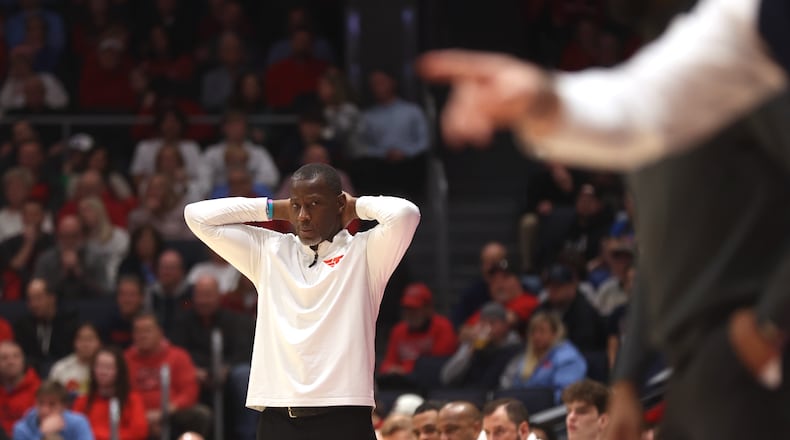“Let’s go!
“What a rush!”
The song is especially popular in the Red Scare student section, where fans jump together in unison to the beat. The title is also an apt word to illustrate what the Flyer Faithful feels over the course of 40 minutes.
The 2024-25 Dayton Flyers have taken their fans a ride that has been as exciting and unpredictable as it has been frustrating and disappointing. It has been a turbulent season, to say the least. Dayton is on track for its fourth straight 20-win season but is also on pace to fall short of two of its biggest goals, winning the Atlantic 10 Conference regular-season championship and winning enough games to earn a NCAA tournament at-large berth.
The website Haslametrics.com sums up Dayton well.
“Dayton has been one of the more erratic teams in NCAA basketball this year (presently ranked 333rd in the country in consistency), which makes forecasting the outcomes of their upcoming games tougher than most,” the computer analysis reads.
Dayton (18-8, 8-5) gets its last extended break of the regular season this week. After a 77-76 victory against Duquesne on Saturday at UD Arena, it plays at Loyola Chicago (16-9, 7-5) at 7 p.m. Friday. That’s the first of five games in a 16-day stretch. Then it’s on to the Atlantic 10 Conference tournament in Washington, D.C.
“It’s going to be good to get some rest, get back to practice and work on the stuff we need to work on,” forward Zed Key said Saturday.
Credit: David Jablonski
What does Dayton need to work on? Here are some stats that explain the Flyers:
1. Overall defense: Dayton ranks 165th in the country in adjusted defensive efficiency (107.2), according to KenPom.com. The number tracks points allowed per 100 possessions but adjusts for the quality of the opponent.
It’ss the second-worst ranking for Dayton in the 29 seasons Ken Pomeroy has tracked the stat and worst ranking since it had the No. 238 defense in the 2017-18 season, Anthony Grant’s first as head coach. In A-10 games, Dayton has the 11th-best defense in a 15-team league.
2. Three-point defense: Teams have shot 34% against Dayton from 3-point range. That’s slightly worse than the national average (33.7%). That’s the second-worst mark of the Grant era, ahead of only the 2017-18 team (38.3).
In three of Dayton’s losses, George Washington, George Mason and St. Bonaventure all shot better than 48% from 3-point range. Dayton also lost a game to Massachusetts despite UMass shooting 15% (3 of 20).
3. Overall offense: Dayton’s offense ranks 38th in the country in adjusted efficiency (117.7). That’s the third-best mark of the Grant era. In A-10 games, Dayton’s offense ranks second in efficiency.
Dayton has five players averaging 10 points or more: Nate Santos (13.8); Enoch Cheeks (12.9); Javon Bennett (10.5); Malachi Smith (10.2); and Zed Key (10.0). Dayton has not had five players average in double figures over the course of a season since the 1963-64 season.
4. Three-point offense: Dayton is shooting 36.2% from 3-point range. That’s the 64th-best mark in the country and the fourth-best percentage of the Grant era. In A-10 play, it’s shooting 36.5%, the best mark in the conference.
Dayton’s top shooters are: Nate Santos (54 of 126, 42.9%); Malachi Smith (22 of 53, 41.5%); Javon Bennett (48 of 122, 39.3%); and Enoch Cheeks (43 of 116, 37.1%). Jacob Conner, Amaël L’Etang and Posh Alexander are all shooting under 30%.
5. Rebounding: In A-10 play, Dayton ranks second to last in the conference in defensive rebounds per game (22). Its offensive rebounding percentage (32.8), which shows how often the opponent grabs an offensive rebound, ranks 13th out of 15 teams.
VCU rebounded its own missed shots on 51.1% of its field-goal attempts against Dayton in a 73-68 victory at UD Arena on Feb. 7. That was Dayton’s worst number of the season. It is 1-4 when an opponent grabs more than 40% of the offensive rebound chances.
Dayton’s offensive rebounding percentage over the whole season (29.7) is the program’s worst since the 2012-13 season.
FRIDAY’S GAME
Dayton at Loyola Chicago, 7 p.m., ESPN2, 95.7, 1290
Credit: David Jablonski
About the Author

